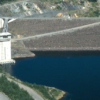Overview
The US Army Corps of Engineers builds, maintains and improves navigation structures on Pittsburgh Pennsylvania’s three rivers – The Allegheny, Ohio and Monongahela. These navigation structures are necessary to make inland waterways viable, year-round transportation corridors.
The Lower Mon Project was initiated by the US Army Corps of Engineers to keep river transport and economical through the lower part of the Monongahela River. The project consists of replacement of the 100 year old fixed-crest dam near Braddock (Locks and Dam 2) with a gated dam (completed in 2002), construction of two new larger locks at the Locks and Dam near Charleroi (Locks and Dam 4) and removal of the Locks and Dam near Elizabethtown (Locks and Dam 3).
Project Objectives
The proposed new Charleroi Locks, each to be 84’ wide by 720’ long, are an essential component of the “two-for-three” replacement plan that will lower the downstream operating pool by 3.2’ after the removal of Locks and Dam 3. This pool lowering, driven by major structural problems at Locks and Dam 3, will result in major impacts to existing Locks 4, namely, differential loading on the lock walls will increase to unacceptable levels and water depths over the lock chamber sills and struts will be lower than required. Existing Locks 4 are 70 years old with thin, un-reinforced, non-air entrained concrete sections founded on wood piles.
The first phase of the new lock construction began in 2004 at Charleroi with the construction of an internally braced cofferdam constructed within the riverside lock chamber and construction of the various monoliths which will form the foundation for the new riverside lock. The landside chamber will remain in operation during this initial phase of construction and until the new riverside lock chamber construction is completed. Maintaining stability of the existing lock walls is a critical requirement for all this construction activity so instrumentation and monitoring was specified by the Corps to provide this information.
What We Did
Instrumentation consisted of 17 Geokon Model 6300 Vibrating Wire In-Place Inclinometers each consisting of 6 or 7 sensors installed in the river and middle walls, to a depth of 105’ (32m), as well as piezometers to provide pore pressure and water level information inside and outside the cofferdam. Four monitoring systems placed approximately in the corners of the cofferdam were required to optimize cabling and connections to the instruments.
Monitoring Requirements
The following key features were required and supported by the monitoring system:
- Lack of power necessitated design of a solar power system to power the systems and audible and visual alarms.
- Lack of hard-wire communications necessitated use of a wireless interface at each system to provide configuration, monitoring and data collection functions to a PC installed above the Dam Tenders office. • High reliability of measurements to avoid false alarms was supported by use of the Canary Systems VWDSP Interface to read the gages.
- Damage from frequent lightning events at the Lock was avoided by use of Canary Systems MultiMux Multiplexers with integrated OVP components on each channel.
- Construction personnel working within the confines of the cofferdam need audible and visual alerts in case either the middle or river walls showed excessive movement, especially during the de-watering phase. This was supported by deployment of high-powered 144dB sirens and strobes at each monitoring system, the system included the necessary solid-state relays and power supplies to activate these devices. The monitoring systems calculated deflection at each inclinometer elevation as well as the total or accumulated deflection of the string.
- Distribution of data was accomplished by use of our MultiLoggerDB software product, this provided automated data collection from all the systems and an easy-to-use interface to the data and the numerous charts and reports for evaluating the performance of the instrumentation. The USACE had remote access to the on-site PC for retrieval of data and chart and report creation. The on-site monitoring PC also provided voice message phone alarm through use of a digital I/O card and voice dialer controlled by Insite, the client data access software of MultiLoggerDB. In 18 months of operation no measurements exceeded the thresholds and no alarms were generated. All systems and components have operated to date with 100% reliability.


